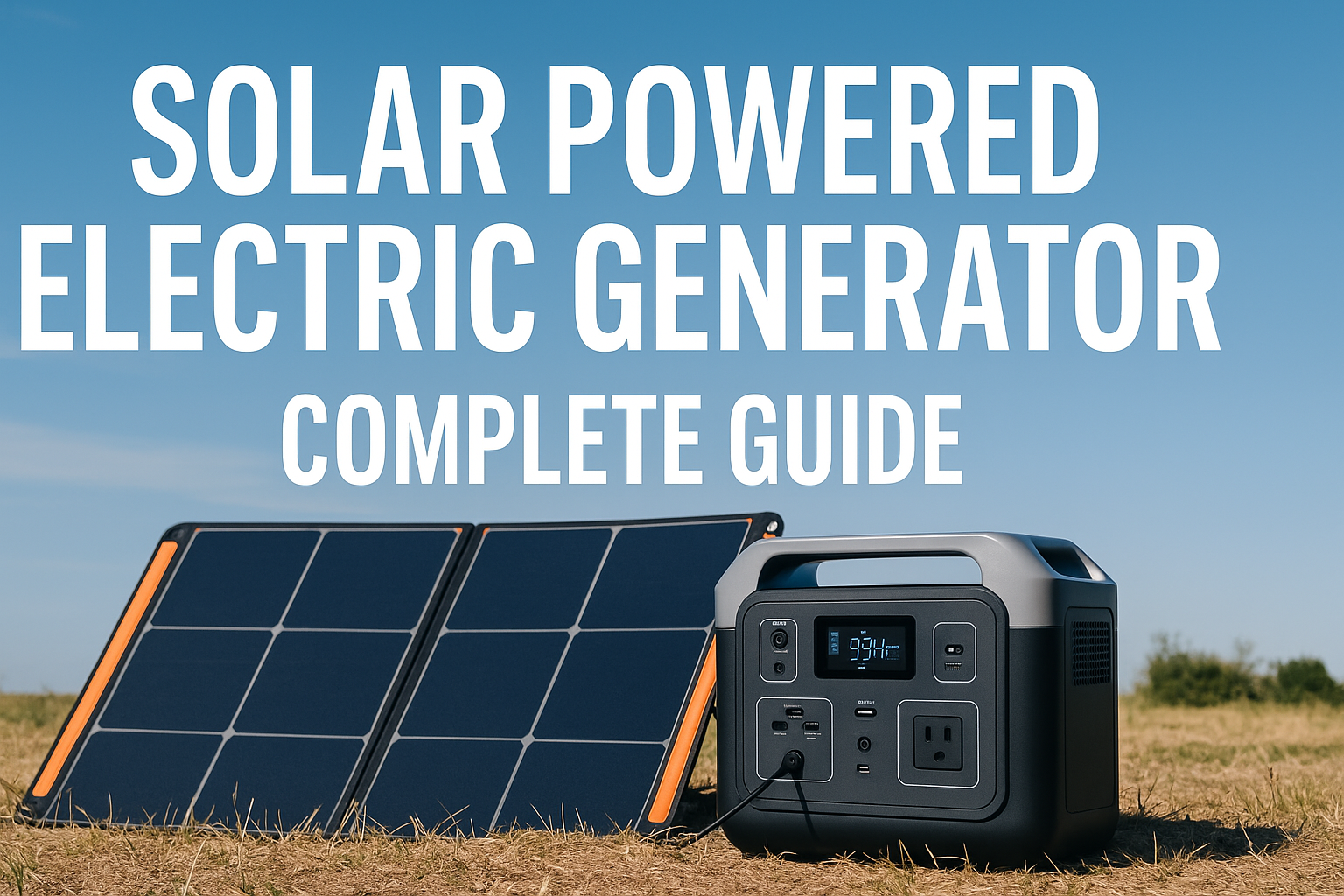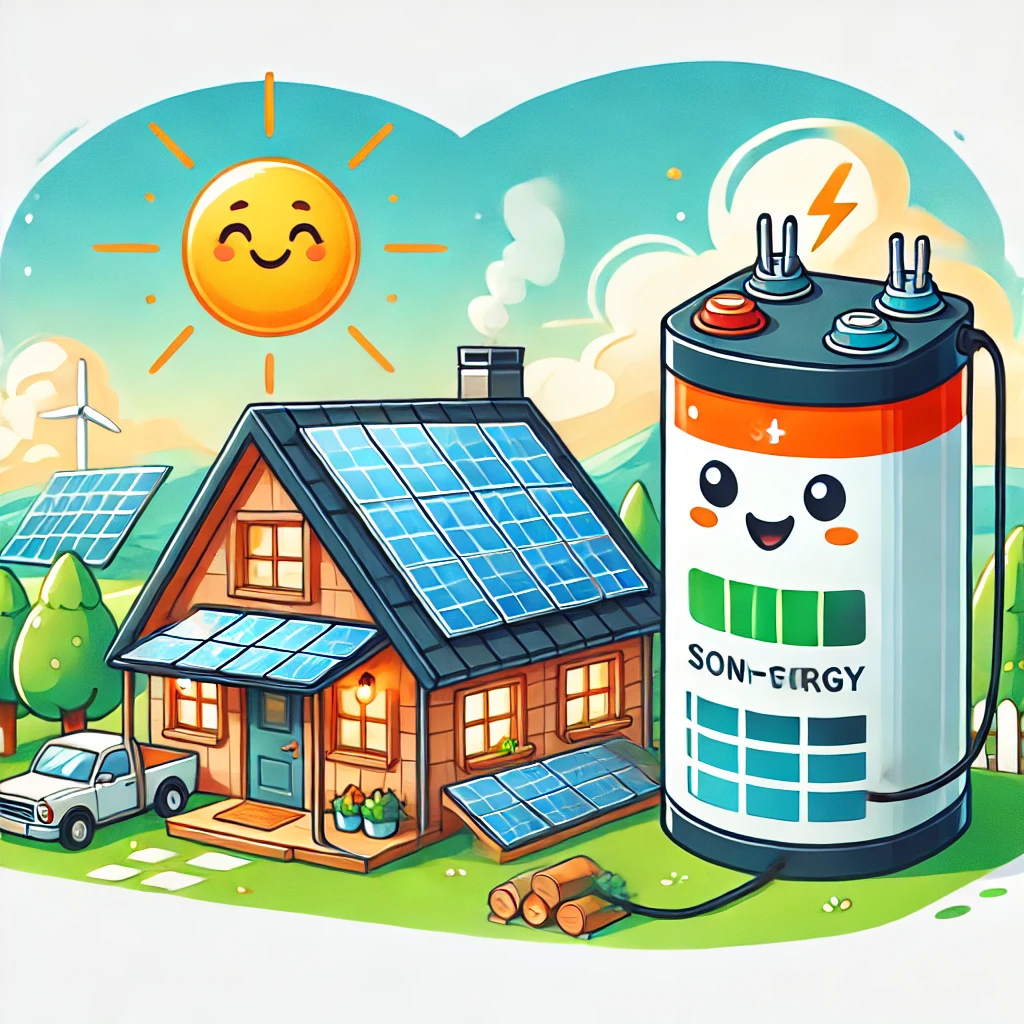Introduction
A solar powered electric generator is one of the most practical solutions for anyone who wants reliable, clean, and renewable electricity without depending on the grid or noisy fuel-powered machines. Unlike traditional gas generators that burn fuel and emit harmful fumes, a solar generator runs quietly by capturing the free energy of the sun.
In today’s world, where power outages, rising energy bills, and climate concerns are becoming more common, solar generators are quickly moving from a niche product to a household necessity. Whether you’re camping, living off-grid, or just preparing for emergencies, these generators provide peace of mind and freedom from fossil fuels.
This article explores everything you need to know about solar powered electric generators—how they work, their components, benefits, challenges, costs, and how to choose the right one for your needs.
What Is a Solar Powered Electric Generator?
A solar powered electric generator is a system that uses solar panels to convert sunlight into electricity, stores it in a built-in battery, and delivers that stored energy through an inverter when needed. In simple terms, it’s a portable power station powered by the sun.
Unlike fuel-based generators, there’s no engine, no fuel tank, and no harmful emissions. Instead, you get quiet, maintenance-free electricity that you can use for appliances, tools, or devices anytime, anywhere.
How Does a Solar Generator Work?
The process of generating electricity with a solar generator can be broken down into four simple steps:
- Solar Energy Collection
Solar panels capture sunlight and convert it into direct current (DC) electricity. - Energy Storage
That electricity flows into a rechargeable battery inside the generator. Most modern models use lithium-ion or LiFePO4 batteries, known for efficiency and long lifespan. - Conversion to Usable Power
Since most appliances and devices run on alternating current (AC), the generator uses an inverter to convert stored DC electricity into AC power. - Power Delivery
You can then plug in your devices, tools, or appliances into the generator’s AC outlets, USB ports, or DC ports—just like using a wall socket.
The beauty of this system is that it runs silently, produces no emissions, and can recharge during the day while providing power at night.
Key Components of a Solar Generator
To better understand solar powered electric generators, let’s break down their main parts:
1. Solar Panels
The generator doesn’t create electricity on its own—it relies on solar panels. Portable panels can be folded and carried, while larger setups use rigid or flexible panels.
2. Battery
The battery is the heart of the generator. It stores energy for later use. Modern units typically use:
- Lithium-ion: Lightweight, efficient, and durable.
- LiFePO4 (Lithium Iron Phosphate): Safer, longer-lasting, but heavier and more expensive.
3. Inverter
Converts DC from the battery into AC so you can run appliances like fridges, TVs, laptops, or medical equipment.
4. Charge Controller
A smart component that regulates the flow of electricity from the solar panels to the battery, preventing overcharging or damage.
5. Outlets & Ports
Modern solar generators come with:
- AC outlets for appliances.
- USB & USB-C ports for devices.
- 12V DC ports for car accessories.
- Some even include 30A RV plugs for mobile living.
Types of Solar Powered Electric Generators
Not all solar generators are built the same. They come in different sizes, capacities, and designs depending on the application.
1. Portable Solar Generators
- Small, lightweight, and easy to carry.
- Ideal for camping, tailgating, or charging phones, laptops, and small appliances.
- Battery capacity usually ranges from 150Wh to 1,000Wh.
- Examples: Jackery Explorer 300, EcoFlow River.
2. Mid-Sized Solar Generators
- Larger battery capacity for running multiple devices and appliances.
- Often used as backup power during outages.
- Capacity ranges from 1,000Wh to 3,000Wh.
- Can power refrigerators, CPAP machines, and TVs.
3. Heavy-Duty Solar Generators
- Designed for whole-home backup or off-grid living.
- Capacity above 3,000Wh, with powerful inverters (3,000–6,000 watts).
- Can run heavy-duty appliances like freezers, pumps, and even air conditioners.
- Often expandable with extra batteries or solar panels.
- Example: Titan Solar Generator, Bluetti AC300.
Advantages of Solar Powered Electric Generators
Why are solar generators gaining popularity so quickly? Here are the main reasons:
1. Clean & Renewable Energy
No fossil fuels, no smoke, no greenhouse gases. They use free solar energy that never runs out.
2. Quiet Operation
Unlike gas generators that roar like lawnmowers, solar generators run silently—perfect for indoors, campsites, or nighttime use.
3. Low Maintenance
With no moving parts, there’s no oil change, spark plug replacement, or fuel filter cleaning. Just charge and use.
4. Portable & Convenient
Many solar generators are compact, easy to carry, and can power everything from a smartphone to a fridge.
5. Cost Savings Over Time
Although the initial cost may be high, you save money by not buying fuel. Plus, solar energy is free forever.
6. Indoor Safe
Since they emit no fumes, you can safely use them inside your home, unlike gas generators that must stay outdoors.
Disadvantages of Solar Powered Electric Generators
Of course, no technology is perfect. Here are some limitations:
1. High Upfront Cost
A reliable solar generator often costs more than a gas generator with similar output.
2. Limited Power for Heavy Appliances
Smaller units may not handle high-wattage appliances like electric stoves or central AC.
3. Sunlight Dependent
Solar charging requires sunlight. Cloudy days or shade can slow recharging unless paired with wall or car charging.
4. Battery Lifespan
While lithium batteries last years, they eventually degrade and may need replacement after thousands of cycles.
5. Slower Recharge Compared to Gas
Even with strong panels, recharging can take several hours, whereas gas generators just need refueling.
Real-Life Uses of Solar Generators
Solar powered electric generators are versatile and practical in many situations:
1. Emergency Backup at Home
During blackouts, a mid-sized solar generator can keep your fridge, lights, router, and medical devices running until the power returns.
2. Outdoor Adventures
Campers, hikers, and RV travelers use solar generators to power portable fridges, lights, cameras, and GPS devices without worrying about fuel.
3. Off-Grid Living
For cabins, boats, or tiny homes, solar generators provide daily power without connecting to the utility grid.
4. Job Sites
Contractors working in remote areas can run tools, lights, and devices without carrying fuel cans.
5. Disaster Relief
In hurricane or wildfire zones, solar generators provide clean, reliable power for communication and medical needs when the grid is down.
How to Choose the Right Solar Powered Electric Generator
With so many options on the market, here are the key factors to consider before buying:
1. Power Output (Inverter Size)
Check the wattage rating.
- Small units (150–500W) → phones, laptops, lights.
- Medium (1,000–2,000W) → fridges, TVs, small appliances.
- Large (3,000–6,000W) → heavy appliances, RVs, off-grid setups.
2. Battery Capacity (Wh / kWh)
Battery size determines how long it can run your devices. For example:
- 500Wh → laptop + lights for several hours.
- 2,000Wh → fridge for 1–2 days.
- 5,000Wh+ → partial home backup.
3. Charging Options
Look for generators that allow:
- Solar panel charging (main source).
- Wall charging (AC) for cloudy days.
- Car charging (DC) while traveling.
- Dual or hybrid charging for faster recovery.
4. Portability
If you’re camping or traveling, weight matters. Some units weigh less than 20 lbs, while heavy-duty ones with batteries can top 150 lbs.
5. Expandability
Check if you can add extra batteries or solar panels. This future-proofs your system as your needs grow.
Cost of Solar Powered Electric Generators
Prices vary depending on size, features, and brand.
- Small portable units: $200–$600
- Mid-sized units: $800–$2,000
- Large backup units: $2,500–$6,000+
- Extra batteries: $800–$2,000 each
- Solar panels: $150–$400 per 100W
Although the upfront cost is higher than a fuel generator, the long-term savings (no fuel, no maintenance, free energy) make solar generators more cost-effective.
Solar Generators vs. Gas Generators
Here’s a quick comparison to help you decide which suits your needs:
| Feature | Solar Generator | Gas Generator |
|---|---|---|
| Fuel Source | Sunlight (free) | Gasoline/Diesel (paid) |
| Emissions | Zero | High (CO₂, fumes) |
| Noise | Silent | Loud (60–90 dB) |
| Maintenance | Minimal | High (oil, filters) |
| Indoor Use | Safe | Unsafe (carbon monoxide risk) |
| Running Time | Limited by battery | Unlimited (as long as fuel is available) |
| Upfront Cost | Higher | Lower |
| Long-Term Cost | Very low | High (fuel + maintenance) |
Verdict:
- For short-term heavy power → gas is cheaper.
- For long-term clean energy & daily use → solar wins.
Future of Solar Powered Generators
The technology is improving rapidly. Expect:
- More powerful lithium batteries with longer lifespans.
- Faster charging with high-efficiency solar panels.
- Bifacial solar panels that collect light on both sides.
- Smart apps for remote monitoring.
- Lower costs as solar tech continues to get cheaper.
In the near future, solar generators may replace gas models entirely for households and businesses.
FAQs About Solar Powered Electric Generators
Q: Can a solar generator power an entire house?
A large system with expandable batteries can power essentials, but not always central AC or electric ovens. For whole-house use, multiple units or hybrid systems are needed.
Q: How long do solar generators last?
With lithium batteries, most last 8–12 years with regular use. Many are rated for 2,000+ charge cycles.
Q: Can I use one during the night?
Yes, as long as the battery is charged during the day, you can use it anytime—day or night.
Q: How many solar panels do I need?
That depends on your generator size. A 1,000Wh unit might recharge with 200–400W of panels, while a 5,000Wh system could need 1,000W or more.
Q: Are they safe indoors?
Yes, unlike gas generators, solar generators are completely safe indoors since they produce no fumes.
Conclusion
A solar powered electric generator is more than just a backup tool—it’s a step toward energy independence and a cleaner future.
- For campers and travelers, it offers quiet, portable power.
- For homeowners, it provides reliable backup during outages.
- For off-grid enthusiasts, it’s a foundation for sustainable living.
While the upfront cost may seem high, the benefits—free solar fuel, silent operation, zero emissions, and low maintenance—make it an investment that pays off for years.
As technology advances and prices fall, solar generators will only become more accessible. Whether you’re preparing for emergencies, reducing your carbon footprint, or seeking portable power freedom, a solar powered electric generator is one of the smartest clean energy solutions available today.


